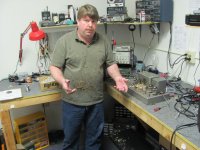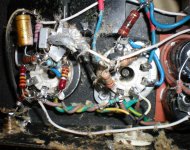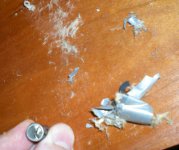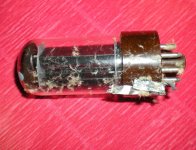Caps aren't the only thing that can explode. I built a V-reg circuit for +/-40V @5A using TO-220 mosfet series pass devices. I accidentally shorted one of the outputs and the transistor exploded. (early lesson about using fuses was learned here ) A chunk of the plastic case hit me in the forehead close to my eye. It left a mark, drew a spot of blood! Less than an inch down and I would be blind in my left eye. I’ve never seen a transistor like that before or since explode leaving a crater in the plastic package where the die used to be before it vaporized.
) A chunk of the plastic case hit me in the forehead close to my eye. It left a mark, drew a spot of blood! Less than an inch down and I would be blind in my left eye. I’ve never seen a transistor like that before or since explode leaving a crater in the plastic package where the die used to be before it vaporized.
The variac is the light blue thing in the corner of the bench. In the description, he mentions powering it up with the variac and light bulb limiter (with the deep blue base) and it apparently worked fine until the cap randomly exploded. Needless to say, I'll be wearing my safety goggles more often. 
- Scott
- Scott
I pressed the exploder button !
Hello guy's, I see that this is an old thread, but I need to post something in response to your questions. I amp the one that got exploded upon.
Attached is a photo of me after the explosion.
It was not a fun experience....
Be safe,
Bernie.
Hello guy's, I see that this is an old thread, but I need to post something in response to your questions. I amp the one that got exploded upon.
Attached is a photo of me after the explosion.
It was not a fun experience....
Be safe,
Bernie.
Attachments
I have exploded just about every kind of electrical component made. Even the new vented caps will explode violently if the failure mechanism can dump energy into the cap faster than it can vent. Plastic cased semiconductors can also explode. I have blown them so bad that there is 3 stubs and a black mark where the transistor used to be. I have even seen the pieces of silicon come through the can on a TO-3. SMPS's powered directly from the power lines are good for a big bang.
When you build something totally outrageous, powered by a 1500 volt 1/2 Amp power supply, you put a 1/4 inch sheet of Lexan between it and yourself, grab a fire extinguisher, then hit the explode button.
The 833A SE Amp Prototype
When you build something totally outrageous, powered by a 1500 volt 1/2 Amp power supply, you put a 1/4 inch sheet of Lexan between it and yourself, grab a fire extinguisher, then hit the explode button.
The 833A SE Amp Prototype
Attachments
reply
The plexi blast shield looks like a good idea! Probably should be 1/2" lexan though? I also have blown up many components, but this was by far the worst. My face was only 4" from the path of the aluminum can as it rocketed to the sealing.
I lost access to my old youtube account and it went away. I will post the video again and put a link in this thread.
Bernie
The plexi blast shield looks like a good idea! Probably should be 1/2" lexan though? I also have blown up many components, but this was by far the worst. My face was only 4" from the path of the aluminum can as it rocketed to the sealing.
I lost access to my old youtube account and it went away. I will post the video again and put a link in this thread.
Bernie
...will explode violently if the failure mechanism can dump energy into the cap faster than it can vent.
I have that problem too. I've offered to hand out Lexan shields, but I've been told cognitive therapy is probably a better option.
..Todd
Last edited:
I'm still laughing at the size of those transformers,
The largest one (behind the yellow meter in the photo posted here) is on a power supply from a tube type Motorola radio transmitter. The power supply is rated for 1500 volts at 1/2 amp. I am sure it could put out a lot more than that if things went wrong. I had 4 of them and tried to give them away. I got no takers so sadly they went to the scrap dealer. The major objection was the weight. The power supply weighed over 100 pounds, 75 of which was in that transformer.
I had that prototype running for 2 days. People could hear my guitar two blocks away. Imagine a 200 watt Fender Champ. That was dissasembled, but I still have the parts to make the final version. It would be cool, especially with that big glowing tube in a clear Lexan box. Unfortunately I doubt that it will ever get built.
I have come to realize that I have at most 30 years of useful life left, and I have enough projects to last 100 years if I don't collect any more stuff. Sherri had the same revelation, and we were paying almost $5K per year to store it all. The "stuff" reduction plan has been under way for several years now. I think we are both down to 2 lifetimes worth of projects left.
I had that prototype running for 2 days. People could hear my guitar two blocks away.
WHAT ? Only two blocks away ? Of course I bound to comment on this; when I was in Jamaica on MN service during the early 1965's; I came across this very excited & noisy exiled kompas group from Haiti (Tabou Combo). Moored up in Port Morant, locals claimed they could hear the kompas music as far as Morant point. That's more than 10 miles up the coast !
There are some CD's about, quality varies but none do any justice to the sheer volume and heavy bass depth (to 31 Hz). HiFi requires an expander. A pity no-more but those who remember the way it was with the bass resonating & shakin' the door & window casements and rattling the corrugated roofs of the village shacks is an experience enough, and of course the rum & bacardi coke.
YouTube - Tabou Combo (Mabouyah) Live
Those who want a winter blues cheer up, see this one. Some of the best music I have ever heard.
YouTube - Tabou Combo - New York City
richy
Exploding tant's and 'lytics are always entertaining, but the real danger are from defective oil capacitors when used in HT applications.
On very rare occasions an oil cap may start to 'gently' spark over between the plates, depositing energy in the oil. This may happen even when the cap is run below its maximum allowed operating voltage, for instance if the oil has been contaminated or has begun to decompose/break up.
When this happens, the oil will start to slowly heat up from the deposited energy, and the pressure inside the sealed cap will rise. Eventually the casing gives way and the cap explodes, spraying a fine mist of extremely hot oil droplets all around. The HT supply is likely to flash over in this event, igniting the oil vapor and thus creating the perfect fuel/air explosion.
A fair few years ago an American radio amateur killed himself and literally leveled his house this way.
This is why large mains transformers with oil insulation have pressure relief valves. Better they burn instead of exploding.
On very rare occasions an oil cap may start to 'gently' spark over between the plates, depositing energy in the oil. This may happen even when the cap is run below its maximum allowed operating voltage, for instance if the oil has been contaminated or has begun to decompose/break up.
When this happens, the oil will start to slowly heat up from the deposited energy, and the pressure inside the sealed cap will rise. Eventually the casing gives way and the cap explodes, spraying a fine mist of extremely hot oil droplets all around. The HT supply is likely to flash over in this event, igniting the oil vapor and thus creating the perfect fuel/air explosion.
A fair few years ago an American radio amateur killed himself and literally leveled his house this way.
This is why large mains transformers with oil insulation have pressure relief valves. Better they burn instead of exploding.
Last edited:
A fair few years ago an American radio amateur killed himself and literally leveled his house this way.
This is why large mains transformers with oil insulation have pressure relief valves. Better they burn instead of exploding.
I'd think you'd better modify after seeing this.
YouTube - transformer explosion
I'd think you'd better modify after seeing this.
YouTube - transformer explosion
Have seen that video before, and many others like it. I could be wrong, but I believe that event was actually intended to develop the way it did, fairly controlled though still catastrophic. It looks like liquid oil is spraying out in gushes shortly before the main ignition occurs (safety valve/controlled failure?). If that amount of oil had been properly misted before ignition, the outcome would have been a totally different one (dead photographer, among others).
Ie. that seems to be a transformer 'burn' and not an 'explosion'. The difference is that in an explosion most of the oil ignites simultaneously across a very large volume of air. The oil in the video wasn't spread out sufficiently for a true explosion to occur, being starved of Oxygen.
The US military has experimented with true air/fuel bombs, and even with a bomb small enough to be carried by a bomber, the result is very similar to a small scale nuclear explosion.
Frank.
Haha, I got some cleaning up to do
I was prototyping a circuit, turned the amp on and there was this big hum telling me this thing ain't working as planned. I didn't turn it off, just waited for something to go massively wrong - those burned out resistors are very easy to troubleshoot. But no, no resistor smell, the first to tell me "you got me messed up' (in a loudly way) was the cap. It was a bypass cap, you can see the burned out cathode resistor in the pic. That 5Y3 was sitting nearby and received some collateral damage.
Curious thing: the metal carcass is intact, looks like a bullet shell. Completely empty and clean in the inside.
I was prototyping a circuit, turned the amp on and there was this big hum telling me this thing ain't working as planned. I didn't turn it off, just waited for something to go massively wrong - those burned out resistors are very easy to troubleshoot. But no, no resistor smell, the first to tell me "you got me messed up' (in a loudly way) was the cap. It was a bypass cap, you can see the burned out cathode resistor in the pic. That 5Y3 was sitting nearby and received some collateral damage.
Curious thing: the metal carcass is intact, looks like a bullet shell. Completely empty and clean in the inside.
Attachments
I was prototyping a circuit, turned the amp on and there was this big hum telling me this thing ain't working as planned. I didn't turn it off, just waited for something to go massively wrong - those burned out resistors are very easy to troubleshoot. But no, no resistor smell, the first to tell me "you got me messed up' (in a loudly way) was the cap. It was a bypass cap, you can see the burned out cathode resistor in the pic. That 5Y3 was sitting nearby and received some collateral damage.
Curious thing: the metal carcass is intact, looks like a bullet shell. Completely empty and clean in the inside.
Sounds like you exceeded the capacitors ripple current rating. A reverse polarity connection maximizes the effect. A stiff power source that won't give up will often lead to a successful launch.
Good thing you didn't loose an eye. Those tiny dipped tantalum capacitors can explode and do such damage. Launched electrolytics can punch holes in ceiling tiles or exit through closed windows.
Play safe.
.
Play safe.
Well I did let it run intentionally knowing something was wrong, guess that's not the way to go but I was never in danger (cowardly hid myself behind a wall). Anyway, it was fun.
Well I did let it run intentionally knowing something was wrong, guess that's not the way to go but I was never in danger (cowardly hid myself behind a wall). Anyway, it was fun.
Nothing cowardly about that at all. I agree allowing the circuit to melt something telltale like an inexpensive resistor is a valid troubleshooting technique...in some unique instances as his may have been, not as a first to try blanket generalization.
- Status
- This old topic is closed. If you want to reopen this topic, contact a moderator using the "Report Post" button.
- Home
- Design & Build
- Parts
- Capacitor explosion.




